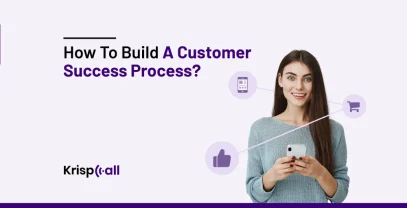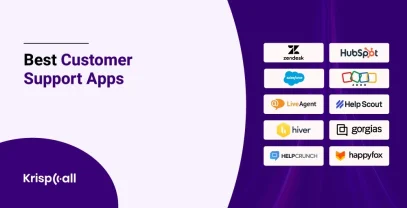Nowadays, customer satisfaction and loyalty have become crucial differentiators for companies. Managing customer relationships and driving consistent success is complex and challenging. 😞
But you can easily build rapport with customers and make them loyal. This is possible with the customer success playbook. 🙂 This strategic framework serves as a roadmap for businesses to consistently deliver value to their customers, enhance their overall experience, and foster long-term relationships.
👍 This guide will discuss the customer success playbook in depth. We also explain a customer success playbook and how to create one.
Let’s get started.
🔐KEY HIGHLIGHTS
- A customer success playbook is a comprehensive framework that guides businesses in managing and nurturing customer relationships.
- Customer success playbooks come in various types, including low engagement, product feedback, account escalation, and many more.
- A customer success playbook can be created by defining the objectives, understanding the customer journey, developing customer segments, establishing key performance indicators, and more.
- The most common examples of a customer success playbook include customer relationship kickup, customer health score playbook, renewal and Upsell playbook, and more.
- A Customer Success Playbook is essential for companies with a standardized approach to managing customer relationships, particularly in the SaaS (Software as a Service) industry.
What is a customer success playbook?
A customer success playbook is a comprehensive guide designed to help customer success teams manage and optimize the customer journey. This framework outlines best practices for addressing customer needs, resolving issues, and providing exceptional service. This results in higher customer satisfaction, as clients feel valued and well-supported.
A Customer Success Playbook helps companies, particularly in the SaaS (Software as a Service) industry, provide clear instructions and procedures for customer-facing teams to follow. This streamlines workflows, reduces confusion and enables employees to work more efficiently, ultimately enhancing team productivity.
Examples of customer success playbooks include the monthly update template for the source graph, the sales and account management hub, and Avoma’s renewal project. Gainsight, Totango, and ChurnZero are some common software tools that can help create and manage a customer success playbook.
What are the types of customer success playbooks?
Businesses use several customer success playbooks to manage and optimize customer interactions.
Let’s delve into the key types of customer success playbooks:
- Low-engagement playbook: A low-engagement playbook is designed to identify customers not actively using a product or service. It involves sending surveys to understand the reasons for low engagement and offering support or additional resources to improve engagement.
- Product feedback and continuous playbook: This playbook focuses on gathering customer feedback to improve product performance and the customer experience. It sends surveys to gather input, analyzes the results, and shares them with relevant departments to drive continuous product enhancements.
- Account escalation playbook: An account escalation playbook communicates with customers about price changes. It provides scripts and materials for discussing price changes and offering alternatives. This playbook helps manage customer expectations and ensures that customers are informed about any changes in pricing or services.
- Risk Playbook: The risk playbook identifies and addresses potential issues or risks that could impact a customer’s success with the product or service. It outlines the actions the customer success team should take to mitigate those risks, such as contacting the customer and offering additional training or resources.
- Onboarding Playbook: An onboarding playbook guides agents on following up with prospects during the onboarding phase. It includes steps such as sending follow-up emails and monitoring progress.
- Health Score Playbook: A health score playbook helps identify early signs of customer churn. It involves calculating health scores based on product usage frequency, support ticket volume, and feedback scores. This playbook enables proactive engagement with customers at risk of churning and helps prevent future losses.
How to create a customer success playbook?
Creating a customer success playbook is constantly changing. It requires knowing your company’s context, customer needs, and ongoing solutions, not just listing what should be included.
Here’s a step-by-step guide to creating such a playbook:
1. Define the objectives
The first step in creating an effective customer success playbook is clearly defining your objectives and goals. Your objectives should be specific, align with your overall business goals, and address the key challenges and pain points. This involves identifying the key goals and outcomes you want to achieve for your customers.
Common goals include improving customer onboarding, increasing customer retention and loyalty, product adoption, reducing churn, and driving expansion revenue. By setting clear goals, you can create a roadmap for success that guides every interaction with your customers.
2. Understand your customer journey
Understanding your customer journey is essential to creating an effective customer success playbook. This involves mapping out your customers’ stages, from onboarding to ongoing support, and identifying each stage’s pain points, challenges, and opportunities.
If you are unsure of customers’ steps, ask them and organize customer feedback surveys to better understand their experiences with your brand. By understanding your customer journey, you can create a playbook tailored to their needs and provide a seamless experience throughout their lifecycle with your company.
3. Develop customer segments
Customer segments are customers with similar needs, behaviors, or characteristics. You can Identify and examine customer attributes and categorize groups based on how they behave, who they are, and their specific characteristics.
By segmenting your customers, you can develop targeted strategies and playbooks that address each group’s unique challenges and opportunities. This will help you provide a more personalized experience for your customers and increase the effectiveness of your customer success efforts.
4. Establish key performance indicators (KPIs)
Establishing Key Performance Indicators (KPIs) is critical to measuring the success of your customer success playbook. You should determine the key performance indicators (KPIs) that will measure customer success, such as NPS, churn rate, and expansion revenue, and align them with the overall business goals and customer success objectives.
Common KPIs for customer success include customer retention rates, net promoter scores, and time-to-value. These KPIs help you track progress, identify areas for improvement, and make data-driven decisions.
5. Create detailed playbooks for each stage
Another step in creating a customer success playbook is to develop detailed playbooks for each customer journey stage. This involves outlining specific actions, strategies, and tactics for each stage, from onboarding to ongoing support.
By creating detailed playbooks, you can ensure that every interaction with your customers is aligned with your overall strategy and that you provide a seamless experience throughout their lifecycle with your company. This will help you build trust, increase customer satisfaction, and drive long-term success.
6. Develop communication guidelines
Effective communication is the backbone of a successful customer success strategy. Establish clear guidelines for how your team should interact with customers, speak clearly, and use a friendly tone with simple words and short sentences. Based on your audit results, you can also set smart goals for your communication plan.
Ensure your communication approach is consistent, empathetic, and tailored to each customer’s preferences. Standardizing your communication practices will create a seamless, high-touch experience that builds trust and loyalty. Hence, empower your team with the right tools, templates, and training to deliver exceptional customer interactions every time.
7. Create a knowledge base
A robust knowledge base is an invaluable asset for your customer success team. Compile a comprehensive repository of product information, troubleshooting guides, FAQs, and best practices.
This centralized resource will equip your agents with the necessary knowledge to provide accurate, efficient support. Encourage your team to contribute to and continuously update the knowledge base, ensuring it remains a dynamic, up-to-date source of truth.
Empowering your agents with the right information will enable them to deliver exceptional customer experiences.
8. Train your team
Your customer success team is your brand’s face, so you should develop their skills and knowledge. Provide comprehensive training to your sales team about your sales products, customer service tips, and techniques with customer success strategies. Equip them with the skills to handle a variety of customer interactions, from onboarding and troubleshooting to upselling and retention.
Ongoing training and coaching will ensure that your team stays up-to-date with the latest best practices and can adapt to evolving customer needs. A well-trained, empowered customer success team will be the key to delivering exceptional experiences.
9. Implement feedback loops
Continuous improvement is essential for a successful customer success playbook. Implement feedback loops that capture customer sentiment, pain points, and suggestions for improvement. Regularly analyze this data to identify areas for optimization and make data-driven decisions.
Encourage your team to actively suggest feedback and use it to refine your processes, resources, and communication strategies. By collecting feedback on user’s needs, you’ll be able to address their concerns and deliver an exceptional experience proactively.
10. Use technology to your advantage
Using advanced technology in a business helps streamline and enhance customer success efforts. Many technologies, such as customer relationship management (CRM) tools, customer success platforms, and other software solutions, can automate workflows, track customer data, and provide valuable insights.
Integrate these technologies into your playbook to create a seamless, data-driven approach to customer success. This will empower your team to work more efficiently, make informed decisions, and deliver a superior customer experience.
11. Monitor and adjust
Continuously monitoring the performance of your customer success playbook and making iterative adjustments is essential for keeping it effective over time. You should monitor key metrics like customer retention rates, expansion revenue, and satisfaction scores to identify areas of success and opportunities for improvement.
Based on the performance data and feedback, specific playbook components can be refined, such as updating workflows and templates. Changes must be tested on a small scale before being rolled out more broadly.
By utilizing a collaborative approach to monitor and adjust the playbook, customer success teams can ensure they deliver consistently high-quality experiences that drive customer loyalty and growth.
12. Celebrate successes
This is the last stage of a customer success playbook. At this stage, you can regularly recognize and reward employees who deliver exceptional customer experiences, such as highlighting specific examples of great service or creative problem-solving.
Sharing real-life customer success stories showcasing the playbook’s positive impact can also be powerful, whether through company meetings, the website, or social media. These are beneficial for customer success managers to make better plans and strategies.
Celebrating achievements as a team rather than individual accomplishments fosters a collaborative culture. Ultimately, making success celebrations a regular part of the company culture and analyzing their impact on customer satisfaction ensures that these efforts reinforce the value of the customer success playbook over time.
Examples of customer success playbook
These are the examples of customer success playbook:
1. Customer relationship Kickoff playbook example
This playbook aims to help businesses start new customer relationships correctly. It establishes a clear 2-4 week timeline for the kickoff process. It outlines the desired outcomes, such as ensuring the customer understands the product/service, has a dedicated point of contact, and feels supported.
The action items for the customer success team include providing a welcome package, scheduling an introductory call, conducting a deep-dive session to review the customer’s use case, identifying any additional training needs, defining success metrics, and outlining the handoff process to the ongoing customer success manager.
2. Customer health score playbook example
This playbook aims to identify early signs of customer churn to address issues proactively. It defines the key metrics and indicators to monitor, including product usage, support engagement, renewal likelihood, and customer satisfaction.
The playbook outlines a scoring methodology that assigns numerical scores to each metric based on predefined benchmarks, calculates an overall health score, and categorizes customers as “healthy,” “at-risk,” or “critical.”
The playbook then provides guidelines for customer success managers on interpreting the scores and taking appropriate actions, such as identifying expansion opportunities for healthy customers, conducting health check calls for at-risk customers, and escalating critical situations to leadership.
3. Renewal and upsell playbook example
This playbook aims to retain customers and expand engagement through renewals and upsells. It defines the renewal cadence and touchpoints, provides a template for renewal call talking points, and identifies upsell triggers based on usage patterns and feature adoption.
This playbook offers sample upsell email templates, outlines the internal approval workflows, and includes a dashboard or reporting template to monitor the renewal and upsell pipeline, close rates, and revenue impact.
By having a structured playbook, the customer success team can deliver a consistent, personalized, and effective renewal and upsell experience across the customer base.
4. Customer quarterly business review playbook example
The QBR (quarterly business review) playbook provides a comprehensive framework for customer success teams to evaluate, strategize, and strengthen client relationships during the current contract period.
This playbook includes a request for a customer testimonial and customer feedback. The QBR playbook ensures a structured, data-driven approach to demonstrating value, addressing customer needs, and identifying growth opportunities.
Conclusion
Customer Success Playbooks are the right strategy and tools for any business looking to optimize its customer success strategy. This framework provides a structured approach to managing customer relationships, which can lead to improved customer satisfaction and loyalty.
Creating a customer success playbook covers everything from onboarding customers to providing ongoing support and identifying opportunities for upsells and cross-sells. The playbook aims to create a consistent and scalable process that helps customers achieve their goals while driving business growth.
So, create customer success playbooks for each stage of your customers’ journeys to provide them with excellent customer service.




